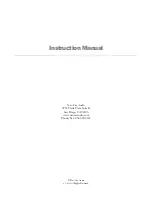
3.2.7 Transmit Level Attenuation
You can manually set the transmit level for a particular value (0, -7.5, -15, or -22.5 dB) or select the automatic
feature that sets the transmit level automatically depending on the receive signal. A weak receive signal causes a
strong transmit signal and vice versa. Use DIP switch LIU–2 to select either the manual or the automatic setting.
If you select the manual setting, set the desired value with DIP switches LIU–3 and LIU–4. Normally, 0 dB is
used when connecting to a network interface box.
Setting The SW2 DIP Switches
Switch
Number
Switch
Position
Function
1 (top)
0 (default)
1
superframe NETWORK IN-BAND loopback
disabled
enabled
2
0 (default)
1
CSU ID (C/R) BIT (ESF MODE)
C/R bit = 0 designates customer premise equipment (CPE)
C/R bit = 1 designates carrier equipment
3
0 (default)
1
RESERVED FOR FUTURE USE
reserved
reserved
4
0 (default)
1
CRC (CYCLIC REDUNDANCY CHECK) FOR ESF MODE
disabled
enabled
5
0 (default)
1
FDL YELLOW ALARM DURING ANSI MESSAGES
disabled
enabled
6
0 (default)
1
B8ZS/COFA LED DEFINITION
COFA (change of frame alignment)
B8ZS detect
7,8
0,0 (default)
0,1
1,0
1,1
MANUAL loopback REQUEST
no loopback
local loopback request
remote loopback request
payload loopback request (ESF only)
NOTE: When changing DIP switch SW2–2 or SW2–5, you must reset the board before the switch is read. With
power on, manually reset the board by inserting a slender object, such as a straightened-out paper clip,
into the small hole located between the Yellow and Syn LEDs on the front-edge panel. You can also reset
the board remotely from a video display terminal or personal computer. A reset causes a T1 service
disruption.
Setting The LIU DIP Switches
Switch
Number
Switch
Position
Function
1 (top)
0 (default)
1
RECEIVE SIGNAL SENSITIVITY
-26 dB
-36 dB
2
0 (default)
1
TRANSMIT LEVEL MODE
Automatic (level set by receive signal)
Manual (level set by switches 3 and 4 below)
3,4
0,0 (default)
0,1
1,0
1,1
TRANSMIT LEVEL ATTENUATION
(LIU-2 must be “1")
0 dB
-7.5 dB
-15 dB
-22.5 dB
Installing The DXPT1 Line Board
IMI89–193
Installing The DXPT1 Line Board – 9
















































